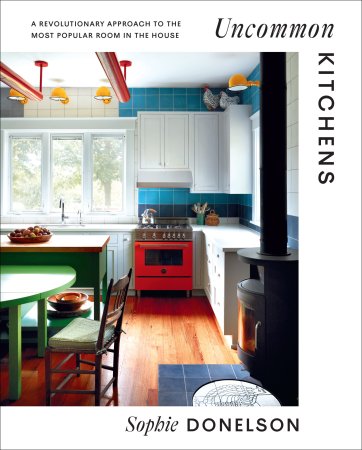We may earn revenue from the products available on this page and participate in affiliate programs.
In her new book, Uncommon Kitchens, home interiors expert and author Sophie Donelson challenges the everyday notions of what we believe a kitchen is for, and as a result, how it should be designed. As we all know, kitchens aren’t just for cooking—they’re gathering places, homework zones, and even dance floors. So how do you design a food-focused space when you’re not much of a foodie? If you’re a professional at procuring takeout or if instant ramen counts as your most daring culinary experience, this excerpt offers a fresh dose of inspiration surrounding kitchens of the anti-chef.

What if we liberated the kitchen from cooking? Forgot the refrigerator-sink-stove “work triangle” and just enjoyed the space as the best room in the house for snacks? It’s a concept that Colombe Studio, a Warsaw design firm, is exploring.

“More and more people admit to never cooking,” says founder Marta Chrapka. “When we don’t have that obligation—when cooking becomes a hobby—the kitchen can become even more attractive and interesting,” she says. “We’re always asking ourselves what sort of cabinets do you even need if you’re dining from delivery.”
What’s cool about Colombe rooms is that they elicit conviviality and food-fueled camaraderie—and most have functions for home chefs—but few are held hostage by the tasks of food prep. The next few pages of Colombe projects shows a range of kitchens that feel free from chores—though each of the kitchens would make a lovely backdrop for them.

Lessons From Marta Chrapka of Colombe Studio, Warsaw, Poland
Start with an idea about design, not function.
Begin with inspiration—it could be Josef Frank furniture, for example. And then consider the story of the people who live there. What’s your way of living? How do you want to feel in the space?
For a kitchen to be cozy, it needs the right light.
Plus fabrics to make the interior softer, and colors, which are especially powerful when dark. Those elements combine to create a feeling of being safe.
Banish long countertops.
They keep you from moving naturally; everything feels too far away. One meter in length feels just right.
One color trick that’s quite easy is to choose paints with natural pigments.
Because these were the coloring agents that were available at the time of older home builds, this makes a color believable in a vintage home.
To reinvent your kitchen again and again, use wood cabinets.
You can repaint them and move the boxes into different configurations. Modern kitchen cabinet materials like MDF and polyurethane paints look plastic, wear out quickly, and can’t be restored. The inability to age things well somehow deprives us of our heritage!
Bright light doesn’t need to be overhead or be bright white.
Direct lighting is good for where you chop, but spotlights aren’t the only solution. Lighting is very personal, but even LEDs offer different temperatures, so go warmer than the strong white or blue-tinted ones that are so common. Also: Dimmers everywhere.
Food needs to breathe.
The cutout shapes in cabinet doors is a 19th-century detail, and it’s specifically for food ventilation. Even when you’re using wood cabinets and natural paints, there’s a specific smell inside. It’s better for food when it’s ventilated—hence the holes.
Decoration can also be useful.
Hang peg railings with necessary but beautiful equipment such as a feather duster or linen cloths.
We have to let go of the fears.
For instance, about what our parents will say. I once created a project for a man who bought fresh food—cheese, bread, wine—and ate it straightaway; there was no fridge, no stove. These creative kitchens will happen, we’re moving closer, but we can’t be beholden to other people’s opinions.
Buy the Book
Uncommon Kitchens: A Revolutionary Approach to the Most Popular Room in the House, by Sophie Donelson
AmazonReprinted from Uncommon Kitchens: A Revolutionary Approach to the Most Popular Room in the House by Sophie Donelson, published by Abrams. Text copyright © 2023 by Sophie Donelson. Photography for pages 40–48 by Colombe Studio and PION Studio. Cover photography by Stephen Kent Johnson/OTTO.

